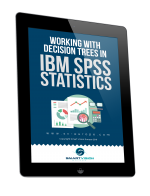A decision tree model is represented visually as a flowchart-like structure that describes an interactive hierarchy of variables with the aim of explaining the variation in a single target (dependent) variable.
Decision trees are used in multiple analytical applications such as churn prediction, customer satisfaction analysis, predictive maintenance, credit risk, estimating offer response likelihood and interpreting cluster analysis results. For example, a direct marketing manager can use decision trees to identify groups of potential responders for inclusion in a forthcoming campaign for a new product or service.
What you will learn
- Introducing decision trees
- How decision trees work
- Selecting variables using a statistical method
- The chi-squared test
- Choosing predictor variables
- The structure of a decision tree
- Building a decision tree
- Creating a decision tree with default settings
- Exploring the model building settings
- Re-building the decision tree
- Working with decision tree output
- Using the tree editor
- Filtering data with the node summary window
- Exploring the Gains table output
- Exploring cumulative gains and performance plots
- Defining profits and misclassification costs
- Working with missing data
- Misclassification costs
- Assigning profile values
- Exhaustive CHAID and CRT
- Using the Exhaustive CHAID method
- Using the CRT method
- Predictor importance and surrogate variables
- Prior probabilities
- Alternative impurity measures
- Validating decision tree models
- Cross-validation
- Split sample validation
- Pruning CRT trees to prevent overfitting
- Scoring data with decision trees
- Scoring cases without dependent variable values
- Scoring data with syntax
- Using the SPSS scoring wizard
- Other decision tree applications
- Decision trees with a continuous dependent variable
- Decision trees with an ordinal dependent variable
- Interpreting cluster analysis results with decision trees
What will I get?
You’ll get access to a full set of training notes from our decision trees training course. The notes cover in detail everything that’s covered in that course, as a step-by-step teach yourself guide. Previously the only way to get hold of these notes would have been to book onto the training course, but we know it’s not always practical to do that so we’re making the notes available as a standalone product.
Who should buy these notes?
The notes give you everything you need to be able to teach yourself how to use SPSS Statistics for decision trees. The course assumes a basic familiarity with the operation of SPSS Statistics. They’ll be a useful resource that you can refer to again and again.
Can I get access to additional help once I have the notes?
Yes, our SPSS Boost service is ideal for this, and we also offer guided online training sessions completely tailored to your requirements.



